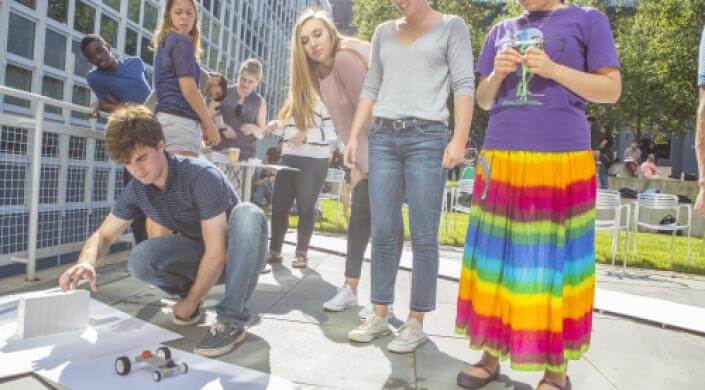News
Tim LaVelle, A.B. '17, a biomedical engineering concentrator, carefully lines up his team's car for its drag race run.
On your mark. . .get set. . .go! With the sharp snap of a rubber band, the student-designed racecar sped down the track toward the finish line. As it rolled across the end of the track, the crowd of onlookers erupted with cheers.
Students in Applied Physics 50 (AP-50) put their team projects to the test during the annual drag race competition on Sept. 24. The hands-on focus of the popular John A. Paulson School of Engineering and Applied Sciences course is one of the elements that draws students from a number of different concentrations. The course includes a series of collaborative projects designed to give students ownership of their learning, explained instructor Eric Mazur, Balkanski Professor of Physics and Applied Physics.
For the first project of the term, Mazur challenged teams of students to design and build a racecar using a kit of supplies that included elastic bands, balloons, springs, and mousetraps. Students constructed and tested their cars in the SEAS Active Learning Labs. Winners were crowned based on the distance their cars traveled on a 14-meter flat track and a 10-meter inclined track.
As he watched his team’s car speed across the finish line of the flat track, Forrest Lewis, A.B. ’17, an earth and planetary sciences concentrator, broke into a broad grin. Lewis attributed the car’s success to its aerodynamic and simple design.
“It is definitely very rewarding to have this kind of finish because of how much we struggled through the process to build something that worked,” he said. “To come out and see our car perform so well is a great feeling.”
Vegas Longlois, A.B. ’16, a folklore and mythology concentrator, celebrated with her teammates after their car zoomed down the track. The keys to their success, she said, were collaboration and persistence.
“We tried a ton of iterations,” she said. “We had about 10 or 15 different models. As a team, we thought about everything we did. Even if we thought something wouldn’t work, we tested it just to be sure.”
In addition to racing their cars on the tracks, team members also presented their projects to panels of judges. They explained the physics and mechanics at work as well as the scientific reasons behind their design choices.
For Mazur, who cheered for all his students as he bounced between the two tracks, shooting cell phone video of the cars in action, the drag race exemplifies what AP-50 is all about.
“In essence, this project is like a Trojan Horse. It hides the physics.” Mazur said. “The students learn the physics and the mechanics, not because I tell them to, but because they want to do their best and win the competition.”
Cutting-edge science delivered direct to your inbox.
Join the Harvard SEAS mailing list.
Press Contact
Adam Zewe | 617-496-5878 | azewe@seas.harvard.edu
